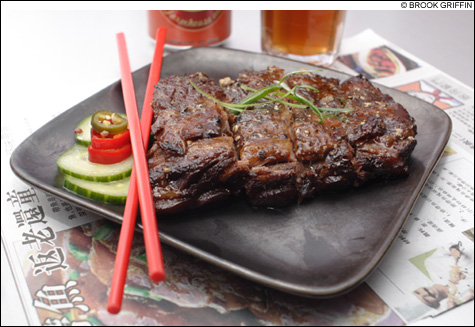
TEA-SMOKED PORK SPARERIBS: slow-roasted, then crisped with Sichuan peppercorns. |
Myers+Chang | 1145 Washington Street, Boston | Open daily, 11:30 am–11:30 pm | MC, VI | Full bar | No valet parking | Sidewalk-level access
617.542.5200 |
Chinese restaurants have given us so much flavor and value that it seems almost rude to point out that Boston hasn’t had a lot of luck with making them upscale. It’s even more daring for a Chinese restaurant to try to go higher-end within a few blocks of Chinatown. As evidenced by Peking Tom’s, to cite a recent attempt, it’s hard to capture the slight campiness of Chinese-American restaurants with enough affection to avoid satire or borderline racism. It’s also surprisingly tricky to fuse Chinese food, even with other Asian cuisines. And when you get to working in European ingredients and techniques, well, there’s Ming Tsai, and there’s everybody else. Myers+Chang is a far surer effort than Peking Tom’s, both in the kitchen (which also draws from other Asian cuisines) and in the design, which is modernized, more spacious, and louder. But it retains enough of the traditional signifiers to make your mouth water for spring rolls, spareribs, and Peking ravioli.So let’s start right there. Mama Chang’s pork and chive dumplings ($11) are the best Peking ravioli I’ve ever tasted, including those from a Chinese-cooking class taught by a recent ex-pat. I don’t know if it’s the family recipe (co-owner Joanne Chang’s mother is from Taiwan) or the chef’s modifications of it that makes them so good. But these five dumplings had the meatiest flavor, the gingeriest undertone, the most perfectly just-charred thin skins, and the most intense garlic-soy dip ever. Tea-smoked pork spareribs ($12) are a somewhat bigger portion, but a much more unusual treatment. They’re slow roasted or poached to falling-apart texture, smoked, and then crisped with Sichuan peppercorns and garlic so they have a crust. If that’s not enough for you, they’re served with a few slices of pickled hot peppers. The spring rolls ($5) come to the table piping hot (which makes the greasiness taste best), with a filling of earthy vegetables (maybe a little seaweed in there?), a thin crisp skin, and an intensely gingery dip.

These aren’t strictly appetizers, because the menu isn’t divided that way, and because the service strategy is to bring everything to the table whenever it comes out from the kitchen. But you can already see why this restaurant succeeds. They can play with the recipes, raise the prices, reduce the portions, and get away with it because they know the important things about the food.
Winter always turns a Chinese-food lover’s thoughts to clay-pot dishes, and the striped bass clay pot ($18) is about as close as Myers+Chang comes to a real entrée. The piece of wild striped bass is what a bistro would serve, but the added clams, black mushrooms, and miso-ham broth make a fabulous soup-stew, and perhaps a richer stock than a traditional clay-pot recipe. The other deviation from tradition is the brown rice ($2 as a side dish) included in the clay pot.
Beef and broccoli chow fun ($12), another of my Chinatown favorites, is a more upscale take on the original, with spicier and higher-quality strips of steak, and the sweeter Chinese broccoli. The flat, soft noodles are the apotheosis of pasta in gravy, but I do like them a little better with some char. No such problem with wok-charred vegetables ($7). These are sort of side orders, but any savvy vegetarian could make a meal of two or three. We had Hakka eggplant ($7), which was hot, greasy, peppery, garlicky, and full of eggplant flavor. The Hakka are a South Chinese ethnic minority with Northern dialect and origins, and their food is very popular in China. Gai lan ($7) is that Chinese broccoli, which doesn’t flower much but is so much sweeter and yummier than European broccoli that I often doubt they’re related. Clams in black-bean sauce ($9) was the one dish for which I’d prefer to hike back to Chinatown. These clams were amusingly tiny, but the sauce was more of a broth, so it was hard to pick up on the fermented-bean flavor.
As I was writing this, I noticed that three of us ordered entirely Chinese food, ignoring the Thai and Vietnamese dishes from chef Alison Hearn. I usually try all corners of a menu, but I guess my relationship with Chinese food is special.
Myers+Chang has a wine list, and with some dishes wine could work. We had a glass of Chateau Leboscq ($10), described by our server as cabernet-merlot, though I think that’s mostly cabernet franc in this secondary Bordeaux. The wine, in a stemless glass, had dark cherry-berry fruit and some length of flavor. The beef chow fun was the best match. A better accompaniment for this food, however, was Tsingtao beer ($5), or Hitachino Nest Red Rice Ale ($8). Hitachino is an oddity in Japan, a microbrewery that tends toward experimentation, using ingredients such as red rice in Belgian-style strong ale. It looks cloudy and reddish-brown, but the flavor is clean, citric, and wine-y, with some malt richness. It’s perfect for this food.